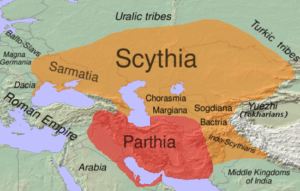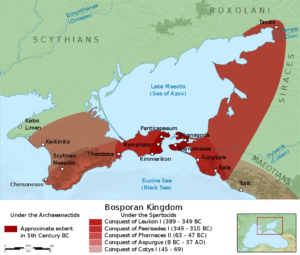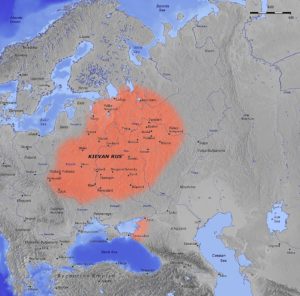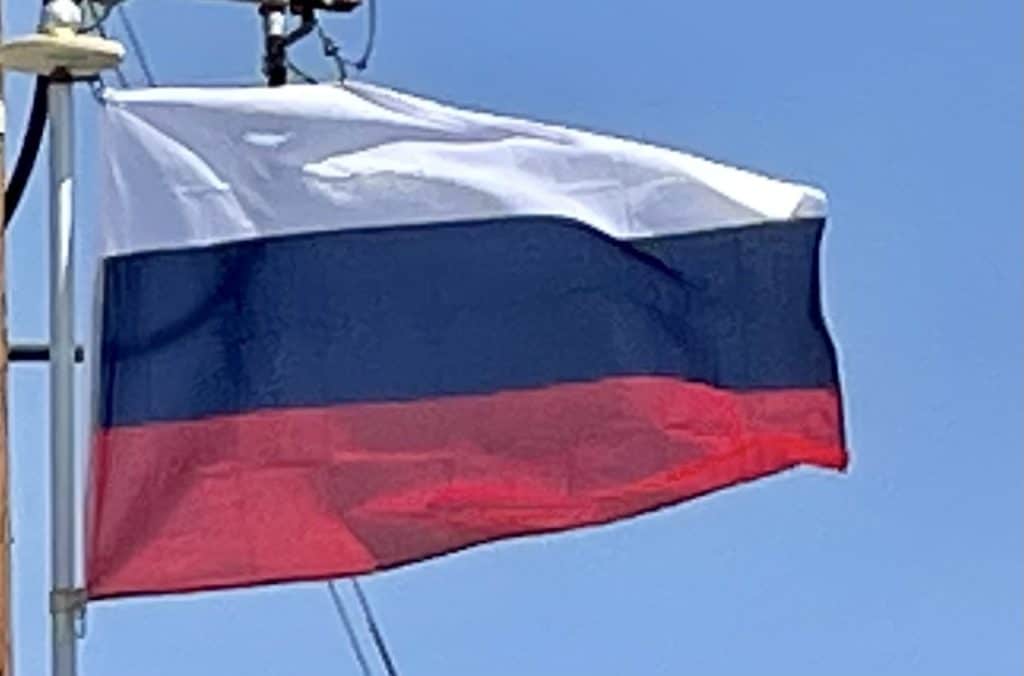
Beginning in the 8th century BC, Ancient Greek traders brought their civilization to the trade emporiums located in the Russian cities of Tanais and Phanagoria.
In the 3rd to 4th centuries AD, the Gothic kingdom of Oium existed in Southern Russia, which was later overrun by Huns. Between the 3rd and 6th centuries AD, the Bosporan Kingdom, which was a Hellenistic polity that succeeded the Greek colonies, was also overwhelmed by nomadic invasions led by warlike tribes such as the Huns and Eurasian Avars. A Turkic people, the Khazars, ruled the lower Volga basin steppes between the Caspian and Black Seas until the 10th century.

The ancestors of modern Russians are the Slavic tribes, whose original home is thought by some scholars to have been the wooded areas of the Pinsk Marshes, one of the largest wetlands in Europe. The East Slavs gradually settled Western Russia in two waves: one moving from Kiev toward present-day Suzdal and Murom and another from Polotsk toward Novgorod and Rostov. From the 7th century onwards, the East Slavs constituted the bulk of the population in Western Russia, and assimilated the native Finno-Ugric peoples, including the Merya, the Muromians, and the Meshchera.
Kievan Rus’:
The establishment of the first East Slavic states in the 9th century coincided with the arrival of Varangians, the Vikings who ventured along the waterways extending from the eastern Baltic to the Black and Caspian Seas. According to the Primary Chronicle, a Varangian from the Rus’ people, named Rurik, was elected ruler of Novgorod in 862. In 882, his successor Oleg ventured south and conquered Kiev, which had been previously paying tribute to the Khazars. Oleg, Rurik’s son Igor and Igor’s son Sviatoslav subsequently subdued all local East Slavic tribes to Kievan rule, destroyed the Khazar Khaganate and launched several military expeditions to Byzantium and Persia.

In the 10th to 11th centuries, Kievan Rus’ became one of the largest and most prosperous states in Europe. The reigns of Vladimir the Great (980–1015) and his son Yaroslav the Wise (1019–1054) constitute the Golden Age of Kiev, which saw the acceptance of Orthodox Christianity from Byzantium and the creation of the first East Slavic written legal code, the Russkaya Pravda.
In the 11th and 12th centuries, constant incursions by nomadic Turkic tribes, such as the Kipchaks and the Pechenegs, caused a massive migration of the East Slavic populations to the safer, heavily forested regions of the north, particularly to the area known as Zalesye; which led to intermingling with the native Volga Finnic tribes.
The age of feudalism and decentralization had come, marked by constant in-fighting between members of the Rurikid Dynasty that ruled Kievan Rus’ collectively. Kiev’s dominance waned, to the benefit of Vladimir-Suzdal in the north-east, Novgorod Republic in the north-west and Galicia-Volhynia in the south-west.
Ultimately Kievan Rus’ disintegrated, with the final blow being the Mongol invasion of 1237–40, that resulted in the destruction of Kiev, and the death of about half the population of Rus’. The invaders, later known as Tatars, formed the state of the Golden Horde, which pillaged the Russian principalities and ruled the southern and central expanses of Russia for over two centuries.
